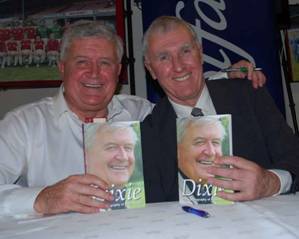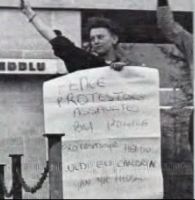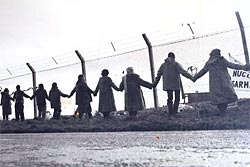Blogs
Upcoming live radio sessions:
Sat 12th Nov - from 8.30am on Radio Cardiff with Jeremy Rees and his 'Soulful Saturday Breakfast Show'. Listen live on www.radiocardiff.org or 98.7 FM (around Cardiff area)
Mon 14th Nov - BBC Radio Wales with Alan Thompson, 'Evening Show'. from 7.30pm. www.bbc.co.uk/radiowales
I was in Carmarthen today. In Narberth members of the Welsh Assembly'sbusiness and enterprise committee are doing a survey. What makes Narberth's cash registers jingle all year round is what they're after. They've already had 'compelling evidence', whatever that means, says Nick Ramsey, AM.
I'm thinking of shops bursting with delicacieslike crumb-crusted deep fried prize winning duck eggs from Hayscastle, Llangloffan award winning hand-made cheeses, 'Calon Lan' organic milk and I've told you umpteen times about everything else: antiques, gorgeous dress shops, glass grapes, ticking cushion covers, hand made cards, Iles- de- Rey type watering cans so you can play at being a peasant a la Marie-Antoinette in her shepherdess outfits and then there is art to make your house look as though youare a person of refinement with exquisite taste anda patron of the arts, rolled into one.
But 'Twsh'to all that: I am too much of a Romantic (note the use of the Capital and think Lord Byron, Keats, the sighs of the 'Lady of Shallot')to think of rateable values and their affects on businesses, (though one of my favourite businesses: Andrew Squire aka the 'Country Squire', objets d'art and whatnots hand delivered to your residence, at a time to suit your convenience,on a Sunday afternoon when the proprietor is on his way toreplenishhis larder for the coming week, hasclosed due to increasing rates and there's the rub, aye).
So, I shall leave the AM's to scratch their own brains and return to my trip to Carmarthen.The car parks were full, but not too full and not too pricey and I had a few happy hours bobbing in and out of shops. Iheaded to King Street and straight into an antiques shop.
Emmawants more old cutlery and I had seen some dessert spoons in a velvet lined box the week before.They were still there and the price was dropped from sixteen pounds to fifteenbecause I've bought there previously. I also bought a fifties cushion cover (five pounds) to embroider and a shopping bag, another five pounds.
I could havebought a loaf of spelt bread in a delicatessen lower down the street, or a quiche, but not today.
Instead I went into acharity shop and bought three 'crinoline lady' cups and saucers and a tray cloth. Next,some grapes in M@S and then my mother and I enjoyed sausage and chipsin the Ivy Bush, where the staff are as good as the food.
The old Carmathen market was claimed to be best antiques market in South and West Wales. I bought an 'Alice in Wonderland' from 'Snooks's' stall when I was young and I used to view the Christmas fowls each year, bedizened and caparisoned in parsley and sage wreaths, surrounded by onions glistening like giant pearl necklaces.
I will admit the new market in Carmarthen does nor resemble the old in any way but the old market, opening only twice a week,never made economic use of the facility.Many people taking part in Welsh language programmes claimed that the closure of the market would change the ethos of a countrytown. Carmarthen has always enjoyed alow unemployment rate and, with the new shopping centre, it hasmoved into the C21th.
Walking around the town today, seeing all the big multiples, Ithought of Emma's comment:'Art for art's sake; money for God's sake'.
Ihave been trying to blog about the anti-capitalist
protestors since they first took up camp, but have held back until I had really
understood what they were about. It would have been too easy to mock them for
moaning about capitalism whilst sleeping in shop-bought tents and chatting on
mobile phones: wearing an itchy jumper does not remove you from being a cog in
a capitalist society.
At first I was scathing if you inherently dont like
capitalism, then you should probably move to a country that has a different way
of organising itself, as 200 people nibbling on stew and sipping at Starbucks
lattes cannot change the way our country has established itself over a thousand
years. But then I listened a bit more and realised that anti-capitalist was
possibly a mis-nomer, and bank re-organisation lobby might be more accurate.
Then I had a bit more sympathy but only a bit.
Yes, bankers earn far more than me but they possibly
generate their company more money than I do to mine. Anti-capitalists tend to
forget that in the private sector people have to earn their company more than
they cost, and that is what determines their level of pay.
Of course, no-one has the right to bring down a bank
especially one that I want to pay my cheque for 37.50 into, but I think bankers
would be even stupider than people think they are if there were all these
wonderful ways of making lots of money, but they turned them down as it might
be a little unfair to earn more than the bloke who potters around in the
wholefood caf round the corner.
The real villains are obviously the people who set the rules
that allowed our banks to exchange their foundations of gold to foundations of traws
(hedging detritus), but 200 people pissing
behind St Pauls Cathedral isnt going to get to the inner circle of them.
I think the thing that sealed my opinion of the
Anti-capitalists was the fact that within hours of setting up camp, they had
established a kitchen tent (maybe fair enough), a prayer room, a library and a
university! To me, if youve time to set up a university, your work has been
done. If I wanted to protest about something,
I would spend my time banging on doors, debating convincingly with people who
can make decisions, and thinking of clever things to say to TV cameras. I
wouldnt spend it arguing about where the tent poles for the prayer room were
put when there is a bloody great cathedral next to it.
Quay Street, Haverfordwest, was formerly known as Ship Street or 'The Rookery'.It was a place of ill-repute,and no respectable person ventured there after dark. Boats, crewed by all nationalities, tied up at the quay and sailors spent their nights drinking in the'Bristol Trader' inn.
Most of the crews were well-behaved despitethe copious tots of 'Old Jamaicy' that were consumed. On 14, August, 1907, two boats from Roscoff arrived, having taken thirty three hours to sail from Brittany with their cargo of onions. There was bad blood between thecrews and a fight broke out. Peace was restored eventually and the rest of the stay passed without incident.
Many of the crew slept 'rough' in the warehouses, or ten to a room in Quay Street.The sailors meant extra revenue for the householders in the street, but standards of living were very basic.
In November, 1913, a representative from the Local Government Board found thatthe state of housing in the town was unsatisfactory, manyhouses inQuay Street falling into this category.
In May, 1914, one hundred and sixty four cases of pulmonary tuberculosis were reported in the Haverfordwest area. A poor standard of housing was cited as a contributory factor.
But, amidst this poverty, there were people who were able to afford the luxury of a motor car.
The first person to take out a car licence in Haverfordwest was Sir Hugh J.P. Thomas. On December 22, 1903, he received the registration DE 2. The speed limit was set at twenty miles per hour.
In November, 1913, Pembrokeshire County Council recognised that the increase in motor traffic and other heavy vehicles was causing wear and tear to the approaches of the County Bridge and it was decided thatforty pounds per year should be spent on keeping this area in good repair.
The local paper carried an advertisement from the garage known as 'S &F Green',wheremotor cars could be repaired. Ladies motoring gloves, hats and veils were also available in the town.
URGENT!!!!!!!! THE WEST COAST EISTEDDFOD NEEDS YOUR HELP! PLEASE READ AND CIRCULATE!
By Ceri Shaw, 2011-11-08
Quick Guide
Go here:- http://apps.facebook.com/chasecommunitygiving/charities/263243673-mlmef click 'Vote and Share' include a message appealing to your FB friends to vote as well. PLEASE REMEMBER TO CLICK 'VOTE AND SHARE' AND NOT JUST THE LIKE BUTTON.
More Info
In 2010 the Meriwether Lewis Memorial Eisteddfod Foundation in association with AmeriCymru participate in the the Chase Community Giving contest on acebook. On that occasion we fell short of making the top 100 by JUST 30 VOTES!!!
This time around we are hoping to make the top 100. BUT we can only do so with your help!
Heres how the prize money is awarded:-
THE WINNER recieves $250,000
THE NEXT FOUR charities each recieve $50,000
THE NEXT 95 each recieve $25,000
We esimate that we will need between 2 and 3 thousand votes to qualify. It's a tall order and there are no guarantees BUT with your help we might just do it.
IN order to vote all you have to do is go to this page:- http://apps.facebook.com/chasecommunitygiving/charities/263243673-mlmef or click on the graphic below, like the app and click 'Vote and Share' Dont forget to add a personal appeal to your friends for their support before you share' PLEASE REMEMBER TO CLICK 'VOTE AND SHARE' AND NOT JUST THE LIKE BUTTON.
OTHER WAYS YOU CAN HELP
1. Email, IM or phone your friends and appeal to them to vote. Remember to tell them that it only takes a second and that all money raised will got to bring Welsh artists and performers over to the US for the West Coast Eisteddfod 2012. This is the most effective method ( particularly IM'ing people on Facebook when they appear in your chat panel ). Use any materials from this blog ( and the others we will be putting out periodically ) to make a standard email to circulate to all your friends.
2. Use the graphic link and or text link from our voting page to embed on your website. This links directly to our voting page.
A THOUSAND DIOLCH'S IN ADVANCE FOR YOUR SUPPORT. WE CAN DO IT!!!!! CYMRU AM BYTH!!!
PLEASE REMEMBER TO CLICK 'VOTE AND SHARE' AND NOT JUST THE LIKE BUTTON.
 Goal machine Dixie McNeil was a star football striker whose career spanned three decades. Dixie played the beautiful game at Leicester, Exeter, Northampton, Lincoln, Hereford and Wrexham. Top goal scorer of all four divisions in the Football League in 19745 and 19756, he played against some of the best sides in the land and in Europe. Hero-worshipped at Wrexham FC, he spent nine years there as a player and later as their manager.
Goal machine Dixie McNeil was a star football striker whose career spanned three decades. Dixie played the beautiful game at Leicester, Exeter, Northampton, Lincoln, Hereford and Wrexham. Top goal scorer of all four divisions in the Football League in 19745 and 19756, he played against some of the best sides in the land and in Europe. Hero-worshipped at Wrexham FC, he spent nine years there as a player and later as their manager.
His new autobiography, called Dixie charts his life in football from those early days as a youngster in the star-studded Leicester squad, which included Gordon Banks and Peter Shilton, to management at Wrexham FC. Following his release from the First Division club, he then joined Exeter City and made his Football League debut at Wrexhams Racecourse ground in August 1966. After Exeter and a stint at Corby Town, he signed for Northampton Town and played in the famous FA Cup tie against Manchester United when George Best replied to Dixies goal with six of his own. He then moved to Lincoln City and, after finishing top scorer in the Football League for two successive seasons, he asked for a 5 a week pay rise and was promptly put on the transfer list by Graham Taylor. He then signed for Hereford United and, with 69 goals, helped the side gain promotion to the Second Division for the first time in their history. But after one season, Hereford United was relegated and Dixie was sold to Wrexham FC for 60,000.
As well as charting the glorious years of Cup and League success at the Racecourse, where Dixie helped the team into the second tier of football, Dixies book gives a humourous insight into life behind the scenes and also marks the differences between the game today and the game in the 1970s. Dixie also comments on the present-day struggles at Wrexham FC.
Dixie certainly mixed with some of the footballing greats. In his foreword tothe book, Graham Taylor, former England Football team manager writes of him, As a player his career record is there for everyone to see: 239 goals in 522 appearances speaks for itself. John Sillett, former Hereford United and Coventry City manager, comments, He had that great ability to score goals, but also good touch and vision and a wonderful understanding you were one of the best signings I ever made.
Dixie McNeil will be signing copies of his autobiography at Ellesmere Books, ELLESMERE on Saturday 26 November 1112.30 and at Waterstones, 1820 Commercial Street, HEREFORD on Saturday 10 December from 11 a.m and at Waterstones, WREXHAM on Saturday 17 December, 122p.m.
Y Lolfa Cyf., Talybont, Ceredigion, CymruSY24 5HE
ffn 01970 831902

www.ylolfa.com
c y h o e d d wy r a c a r g r a f f w y r
St. Mary's Church, Haverfordwest, isone of the finest examples of Perpendicular, or Early English,architecture. Originally, it had a spire but this was damaged during the C18thand never replaced.
Following the capture of Jerusalem by Saladin, Giraldus Cambrensis came to Haverfordwest in 1188, accompanied by the Archbishop of Canterbury, Archbishop Baldwin. Their mission was to recruit volunteers for the Third Crusade and it is thought they occupied the pulpit at St. Mary's.
Gerald, Archdeaconof Brecon, refers to himself in the third person when he says: 'Although the Archdeacon addressed them both in Latin and the French tongues, those persons who understood neither of those tongues were equally affected and flocked in great numbers to the Cross'.
Wives tried to dissuade their husbands from going, not wishing to be widows of a Holy War.
Gerald, ever themysogynist, was wholly disapproving oftheir sentiments: 'Nor is it wonderful if a woman follows her innate evil bent. For it is written in Ecclesiastes:"I have found one good man out of a thousand, but not one good woman", he trumpeted.
This was the Age of Faith anda statue in St. Mary's Church is of a pilgrim, bearing a purse with the scallop shell insignia, showing he has journeyed to Santiago de Compostella in Spain.
Not far from St. Mary'sstands a memorial, erected in 1912, recording the martyrdom of William Nicoll, burnt at the stake on 9th April, 1588, during the reign of Bloody Mary. Little is known of Nicoll, but he wasthougt to be a simpleton by some: 'This William Nicoll was so simple a good soule that many deemed him half foolish'.
Moving on to Victoriam times, market stalls were set up outside the church and the Llangwm fisherwomen were a feature most weeks.
It is a cold frosty sparkle of a night here and the gritter has passed by andmy mind has turned tothe Victorian 'tramp', or vagrant.
Haverfordwest had about eightlime kilns at least during the C19th. On clear nights, sparks from the kilns blistered the skies, making them beacons forhomeless tramps. Many could be found huddled around a kiln and the more daring often slept on top of a kiln.
In 'Chiaroscuro' Augustus John recalls that tramps had been known to fall in and become asphyxiated by the fumes. By the morning, all that remained was a pile of ashes.
Vagrancy was a social problem. In Quay Street, Mrs Powers kept a lodging house where tramps could spend the night.The alternative was the workhouse, whichallowed a night's lodging and breakfast in return for chopping wood or breaking stones.
These tasks weremeant as a discouragement. Treffgarne stone was usually supplied to the Workhouse but when the Haverfordwest Board of Guardians met in 1913, the Clerk reported that the vagrants had complained this stone was very difficult to split and too hard for them.
The 'Pembroke County Guardian' was sympathetic, writingthat 'the poor vagrants said that the (Workhouse) Guardians did it deliberately'.
It was decided that the Guardians should approach firms in Bolton Hill and Porthgain with a view to supplying softer stones in future.
A popular song of the time was:
'Mr Rees of Cartlett Mill
Burnt himself upon the kiln,
Gave the girls a penny a piece
To rub him over with candle grease.
Did you ever see, did you ever see,
Did you ever see such a funny thing before?'
On February 13, 1907, the Haverfordwest local paper reported that a meeting of the Women'sSocial and Political Union had taken place in London.The aims of the union were to extend the Parliamentary franchise and make it equal for men and women, regardless ofmarital status.
The following year, in 1908,the suffragette movement decided to campaignin Haverfordwest.
Mrs Massy and Miss Elsie Gye were the first to arrive, staying at the Mariners' Hotel.They wanted to publicise their campaign and gainlocal support.
News of the arrival spread like wild fire and there was great excitement.
On the evening of July 1st, a large crowd gathered in Castle Square to hear Miss Gye speak.
She introduced herself by saying she was one of the most militant members of the suffrage movement and was proud of having been to Holloway for her beliefs.
Aweek later, Emmeline Pankhurst, the most famous of the suffragettes, arrived. On the Saturday afternoon she made an eloquent speech from the balcony of the Mariners' Hotel.
When asked if she was in favour of votes for married women she replied that she wanted the vote for women on the same conditions that men had it. If Asquith's government pledged it's support for women's suffrage on the same terms as men had it,she would cease her campaign.
The demands of the suffragettes were moderate, merely asking for equalityregarding voting rights.Well received in Haverfordwest, these women were mocked by many and fought a bitter fight against enormous prejudice from men and their own sex.
 A memorial bench to Helen Thomas, a peace campaigner killed while taking part in the Greenham Common Womens Peace Protest, has been unveiled in the centre of Newcastle Emlyn by the town clock. Helen was born and went to school in Newcastle Emlyn and her family still have a business there. Aged only 22, Helen died after being struck by a police vehicle in 1989. Folk singer Dafydd Iwan wrote a song about Helen, Cn i Helen and took part in the ceremony honouring Helen where Mayor Hazel Evans said the town council honoured her memory and her commitment to peace and her fight against nuclear weapons.
A memorial bench to Helen Thomas, a peace campaigner killed while taking part in the Greenham Common Womens Peace Protest, has been unveiled in the centre of Newcastle Emlyn by the town clock. Helen was born and went to school in Newcastle Emlyn and her family still have a business there. Aged only 22, Helen died after being struck by a police vehicle in 1989. Folk singer Dafydd Iwan wrote a song about Helen, Cn i Helen and took part in the ceremony honouring Helen where Mayor Hazel Evans said the town council honoured her memory and her commitment to peace and her fight against nuclear weapons.
The Occupy movement has filled our media who struggle to understand the nature of protest which is not accompanied by a list of demands. Thirty years ago Wales kicked off another protest which lasted for 19 years. The Greenham Common Peace Camp, where Helen Thomas sadly lost her life, was started in September 1981 by a Welsh group, Women for Life on Earth, who travelled to RAF Greenham Common in Berkshire to protest against the decision of the British government to allow Cruise missiles (nuclear weapons) to be sited there. The Women for Life on Earth group walked 120 miles from Cardiff to Greenham Common and on reaching their destination they chained themselves to the perimeter fence. They were joined by women from across the UK and during the height of the protests, thousands of women blocked the entrances to the base, cut through perimeter fences and formed human chains around the site.
 There were some huge demonstrations during the tenure of the Peace Camp. In December 1982, 30,000 women joined hands around the base at the Embrace the Base event. On 1 April 1983, some 70,000 protesters formed a 14 mile human chain from Greenham to Aldermaston and the ordnance factory at Burghfield. Another encircling of the base occurred in Dec 1983, with 50,000 women attending. Sections of the fence were cut and there were hundreds of arrests.
There were some huge demonstrations during the tenure of the Peace Camp. In December 1982, 30,000 women joined hands around the base at the Embrace the Base event. On 1 April 1983, some 70,000 protesters formed a 14 mile human chain from Greenham to Aldermaston and the ordnance factory at Burghfield. Another encircling of the base occurred in Dec 1983, with 50,000 women attending. Sections of the fence were cut and there were hundreds of arrests.
The women were ultimately successful as the Cruise missiles were removed in March 1991. The airbase was closed in 1993 but the peace camp remained until 2000. The attention they received prompted the creation of other peace camps at more than a dozen sites in Britain and elsewhere in Europe so the Occupy movement is not breaking new ground. There are two clear lessons for Occupy from the Greenham Peace Camp.
- You have to be prepared to be there for the long haul
- Despite all the Police, the Media, the Courts and Local Authorities throw at you peaceful protest is the way to succeed
 Occupy is beginning to succeed. It has caused the St Pauls authorities to (finally) take a principled stand and Ed Milliband to (finally) come off the fence. Thoughtful people are starting to think the issues through and Im optimistic that the most powerful force for change, public opinion, will gradually start to bring about the changes our society needs.
Occupy is beginning to succeed. It has caused the St Pauls authorities to (finally) take a principled stand and Ed Milliband to (finally) come off the fence. Thoughtful people are starting to think the issues through and Im optimistic that the most powerful force for change, public opinion, will gradually start to bring about the changes our society needs.

